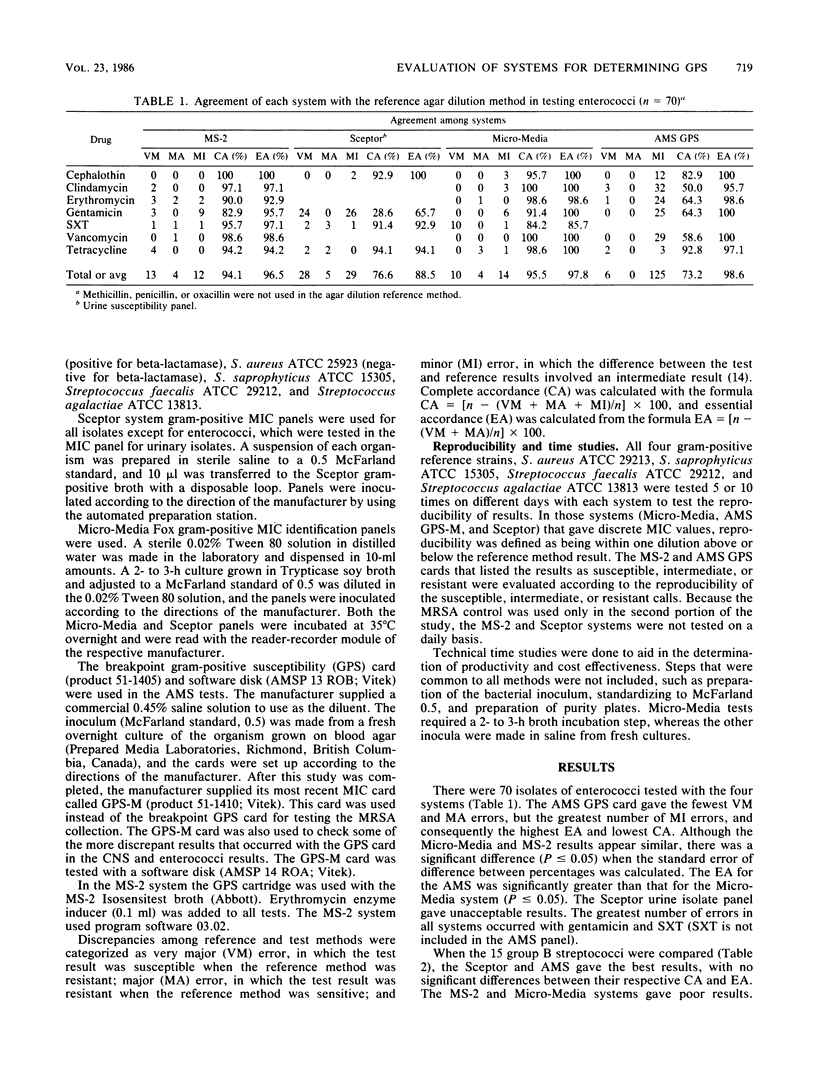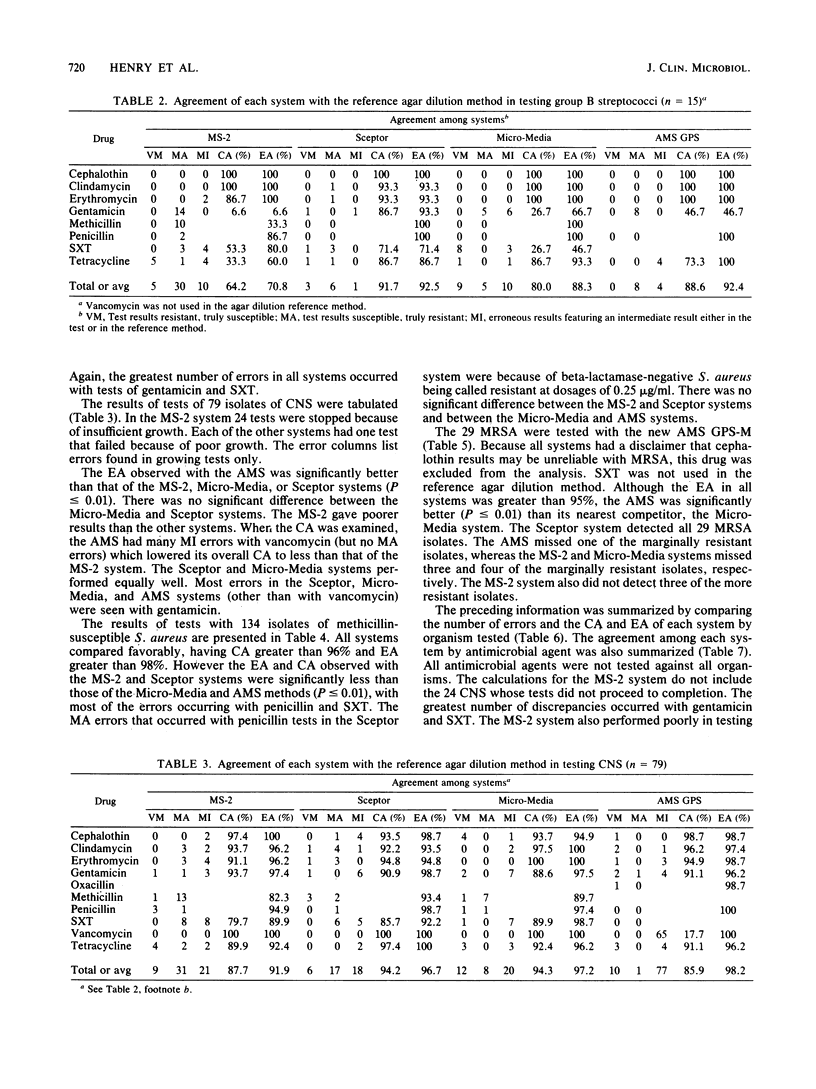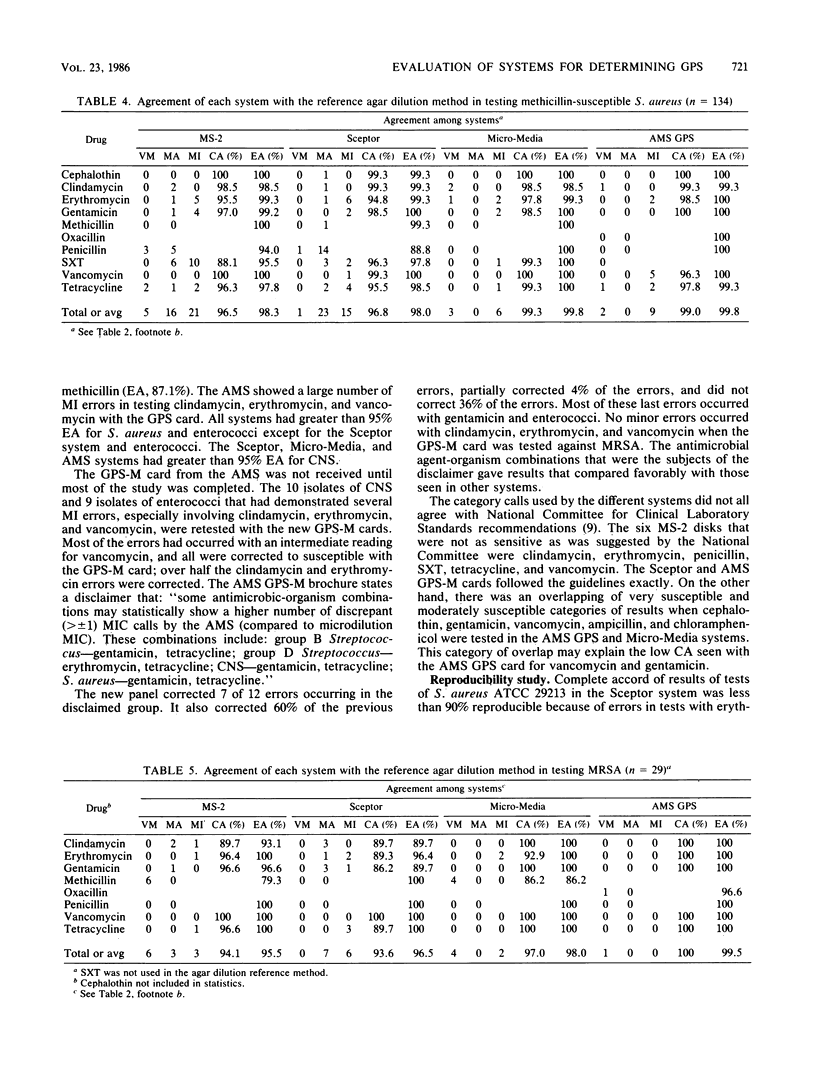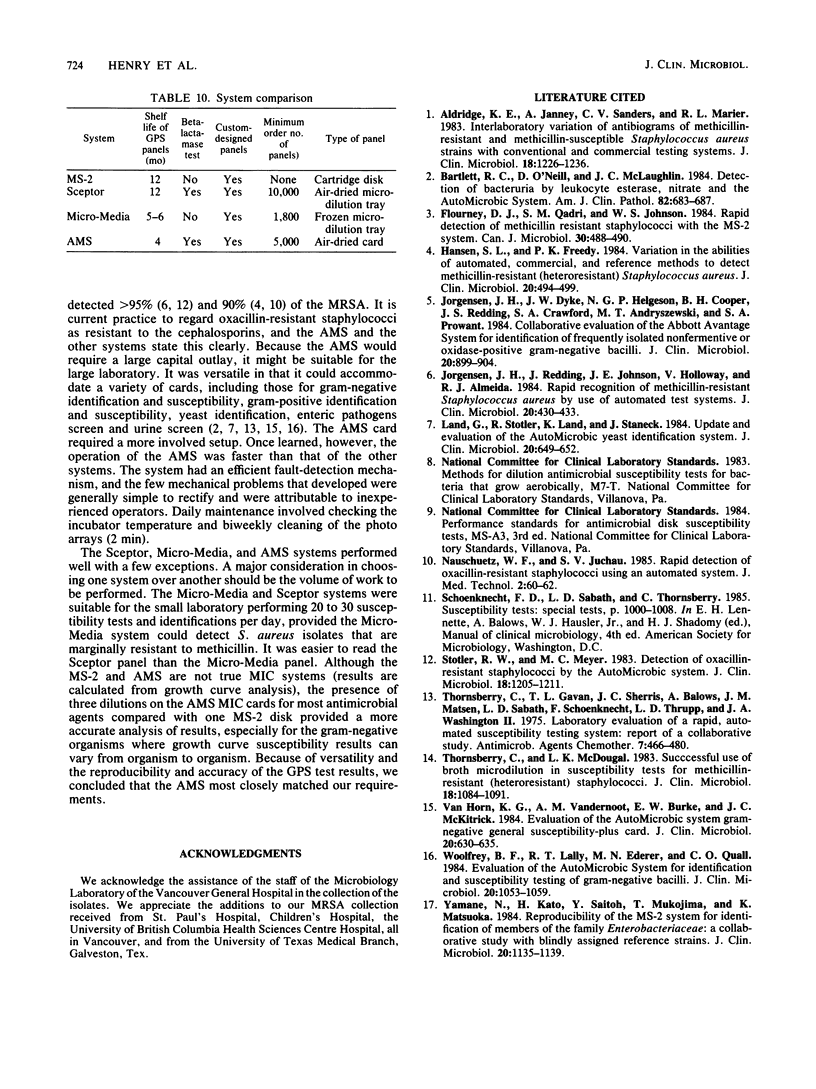Abstract
A study was undertaken to compare four commercial systems for testing the antimicrobial susceptibility patterns of gram-positive cocci. The reference method was an agar dilution method. The systems evaluated were the MS-2 system (Abbott Diagnostics Div., Mississauga, Ontario), the AutoMicrobic system (AMS) (Vitek Systems, Inc., Hazelwood, Mo.) with the gram-positive susceptibility (GPS) card, the Sceptor system (BBL Microbiology Systems, distributed by Becton Dickenson, Canada Inc., Mississauga, Ontario), and the Micro-Media system (Beckman Instruments, Inc., Anaheim, Calif.). There was a greater than 98% essential accord (EA) between all test results and the reference method results when testing 134 isolates of Staphylococcus aureus. In testing 79 isolates of coagulase-negative staphylococci the EA was greater than 97% with all systems except the MS-2. In the MS-2 system only, 30% of tests were interrupted by the instrument because of insufficient growth in the control chamber. Excluding the Sceptor system, the EA was greater than 96% on testing 70 isolates of enterococcus. In testing 15 isolates of group B Streptococcus there was 91% EA with the AMS and Sceptor systems and only 71 and 88% EA with the MS-2 and Micro-Media systems, respectively. The new AMS GPS MIC card was tested against 29 methicillin-resistant S. aureus, 10 coagulase-negative staphylococci, and 9 enterococci, and it gave more accurate results than the earlier GPS breakpoint card. The Micro-Media and MS-2 systems did not reliably detect marginally methicillin-resistant S. aureus. The MS-2 was the least expensive system to operate on a cost per test basis ($3.59 Can.), whereas the Sceptor was the most expensive system ($5.29 Can.). The AMS ws the least labor intensive (0.9 min per test), and the Sceptor system was the most time consuming (2.9 min per test).
Full text
PDF






Selected References
These references are in PubMed. This may not be the complete list of references from this article.
- Aldridge K. E., Janney A., Sanders C. V., Marier R. L. Interlaboratory variation of antibiograms of methicillin-resistant and methicillin-susceptible Staphylococcus aureus strains with conventional and commercial testing systems. J Clin Microbiol. 1983 Nov;18(5):1226–1236. doi: 10.1128/jcm.18.5.1226-1236.1983. [DOI] [PMC free article] [PubMed] [Google Scholar]
- Bartlett R. C., O'Neill D., McLaughlin J. C. Detection of bacteriuria by leukocyte esterase, nitrite, and the automicrobic system. Am J Clin Pathol. 1984 Dec;82(6):683–687. doi: 10.1093/ajcp/82.6.683. [DOI] [PubMed] [Google Scholar]
- Flournoy D. J., Hussain Qadri S. M., Johnson W. S. Rapid detection of methicillin-resistant staphylococci with the MS-2 system. Can J Microbiol. 1984 Apr;30(4):488–490. doi: 10.1139/m84-071. [DOI] [PubMed] [Google Scholar]
- Hansen S. L., Freedy P. K. Variation in the abilities of automated, commercial, and reference methods to detect methicillin-resistant (heteroresistant) Staphylococcus aureus. J Clin Microbiol. 1984 Sep;20(3):494–499. doi: 10.1128/jcm.20.3.494-499.1984. [DOI] [PMC free article] [PubMed] [Google Scholar]
- Jorgensen J. H., Dyke J. W., Helgeson N. G., Cooper B. H., Redding J. S., Crawford S. A., Andruszewski M. T., Prowant S. A. Collaborative evaluation of the Abbott Avantage system for identification of frequently isolated nonfermentative or oxidase-positive gram-negative bacilli. J Clin Microbiol. 1984 Nov;20(5):899–904. doi: 10.1128/jcm.20.5.899-904.1984. [DOI] [PMC free article] [PubMed] [Google Scholar]
- Jorgensen J. H., Redding J., Johnson J. E., Holloway V., Almeida R. J. Rapid recognition of methicillin-resistant Staphylococcus aureus by use of automated test systems. J Clin Microbiol. 1984 Sep;20(3):430–433. doi: 10.1128/jcm.20.3.430-433.1984. [DOI] [PMC free article] [PubMed] [Google Scholar]
- Land G., Stotler R., Land K., Staneck J. Update and evaluation of the AutoMicrobic yeast identification system. J Clin Microbiol. 1984 Oct;20(4):649–652. doi: 10.1128/jcm.20.4.649-652.1984. [DOI] [PMC free article] [PubMed] [Google Scholar]
- Stotler R. W., Meyer M. C. Detection of oxacillin-resistant staphylococci by the AutoMicrobic system. J Clin Microbiol. 1983 Nov;18(5):1205–1211. doi: 10.1128/jcm.18.5.1205-1211.1983. [DOI] [PMC free article] [PubMed] [Google Scholar]
- Thornsberry C., Gavan T. L., Sherris J. C., Balows A., Matsen J. M., Sabath L. D., Schoenknecht F., Thrupp L. D., Washington J. A., 2nd Laboratory evaluation of a rapid, automatic susceptibility testing system: report of a collaborative study. Antimicrob Agents Chemother. 1975 Apr;7(4):466–480. doi: 10.1128/aac.7.4.466. [DOI] [PMC free article] [PubMed] [Google Scholar]
- Thornsberry C., McDougal L. K. Successful use of broth microdilution in susceptibility tests for methicillin-resistant (heteroresistant) staphylococci. J Clin Microbiol. 1983 Nov;18(5):1084–1091. doi: 10.1128/jcm.18.5.1084-1091.1983. [DOI] [PMC free article] [PubMed] [Google Scholar]
- Van Horn K. G., Vandernoot A. M., Burke E. W., McKitrick J. C. Evaluation of the AutoMicrobic system Gram-Negative General Susceptibility-Plus Card. J Clin Microbiol. 1984 Oct;20(4):630–635. doi: 10.1128/jcm.20.4.630-635.1984. [DOI] [PMC free article] [PubMed] [Google Scholar]
- Woolfrey B. F., Lally R. T., Ederer M. N., Quall C. O. Evaluation of the AutoMicrobic system for identification and susceptibility testing of gram-negative bacilli. J Clin Microbiol. 1984 Dec;20(6):1053–1059. doi: 10.1128/jcm.20.6.1053-1059.1984. [DOI] [PMC free article] [PubMed] [Google Scholar]
- Yamane N., Kato H., Saitoh Y., Mukojima T., Matsuoka K. Reproducibility of the MS-2 system for identification of members of the family Enterobacteriaceae: a collaborative study with blindly assigned reference stains. J Clin Microbiol. 1984 Dec;20(6):1135–1139. doi: 10.1128/jcm.20.6.1135-1139.1984. [DOI] [PMC free article] [PubMed] [Google Scholar]


